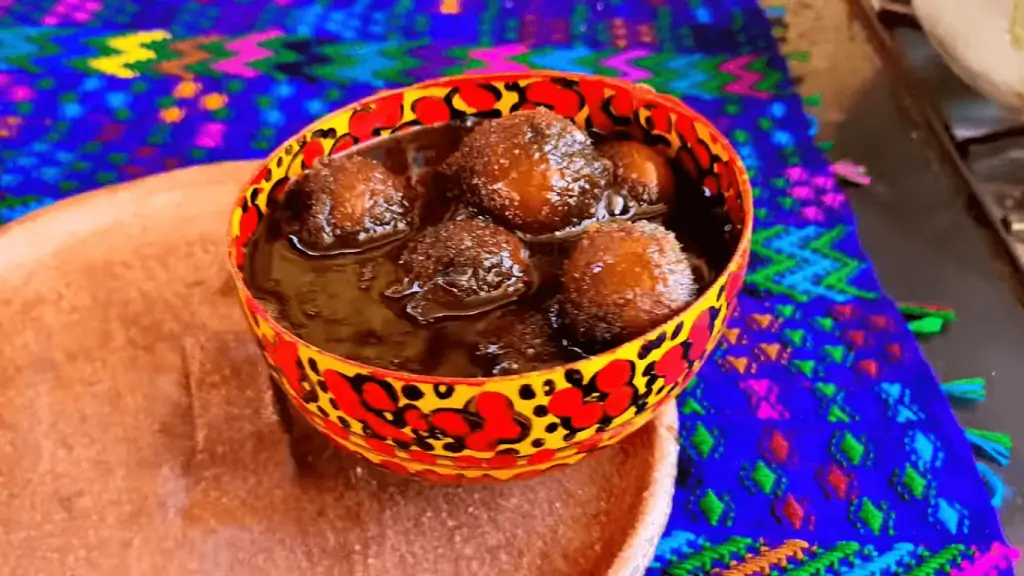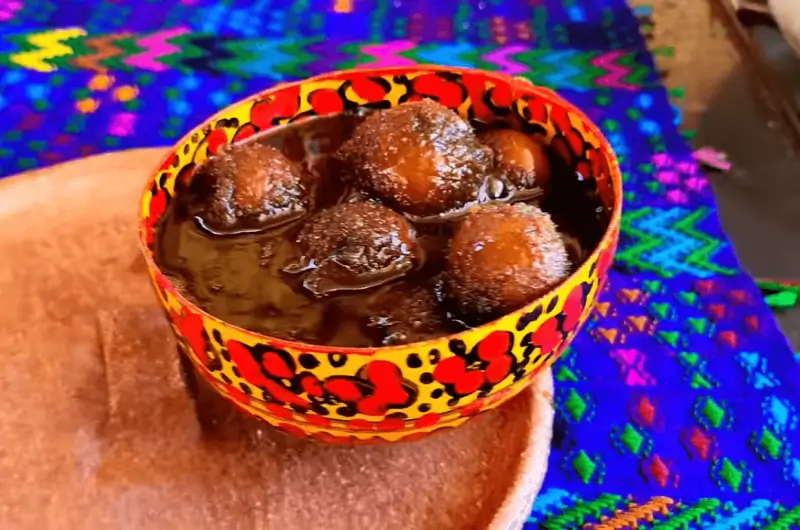The Best Fluffy Pancakes recipe you will fall in love with. Full of tips and tricks to help you make the best pancakes.
Are you ready to embark on a tantalizing journey of flavors and culture? Today, we’re diving into the delectable world of “coyoles en miel,” a delightful treat that has captured the hearts and taste buds of many. From its humble origins to its modern interpretations, we’ll uncover the secrets behind this mouthwatering delicacy. So, fasten your seatbelts as we delve into the sweet wonders of “coyoles en miel.”
Picture this: a warm afternoon, a rustic marketplace, and the enchanting aroma of “coyoles en miel” wafting through the air. This traditional Mesoamerican treat has a rich history and a captivating taste that has transcended time.
Exploring the Sweet Delights of “Coyoles en Miel”: A Culinary Adventure

Table of Contents
Origins
The origins of “coyoles en miel” trace back to the heart of Mesoamerica, a region rich in history, culture, and culinary traditions. This delectable treat has its roots deeply intertwined with ancient civilizations that revered the bounty of the land and harnessed the flavors of nature to create a unique delicacy.
- Ancient Mesoamerica: Long before the advent of modern culinary techniques, the indigenous communities of Mesoamerica had already established a profound connection with the land and its offerings. Among these treasures were the coyol palm trees, which bore a sweet and succulent fruit that would later become the star ingredient of “coyoles en miel.”
- The Coyol Palm: The coyol palm (Acrocomia mexicana) played a crucial role in the daily lives of these ancient civilizations. Its fruits, known as coyoles, were not only enjoyed for their natural sweetness but also cherished for their versatility. From nourishment to crafting materials, the coyol palm provided sustenance and resources to the communities.
- An Art Passed Through Generations: The process of transforming coyoles into the delightful treat known as “coyoles en miel” was an art that was passed down from generation to generation. The ancient Mesoamericans mastered the technique of carefully preparing and cooking the coyoles to achieve the perfect balance of flavors.
- Symbolism and Significance: Beyond its delicious taste, “coyoles en miel” held deep symbolism for these civilizations. The act of combining the natural sweetness of the coyol fruit with the richness of honey represented a harmonious relationship between humans and nature. The treat was often enjoyed during ceremonies, celebrations, and communal gatherings, further solidifying its importance in their culture.
- coyoles en miel Today: As time marched forward, “coyoles en miel” continued to evolve while preserving its essence. The dish survived the test of time, transcending generations and geographical boundaries. Today, the recipe may have undergone slight modifications, but its core remains a tribute to the culinary ingenuity of the Mesoamerican people.
In a world where culinary innovation is celebrated, “coyoles en miel” stands as a reminder of the importance of preserving traditions. As people around the globe savor this delectable treat, they are also tasting a slice of history—a testament to the resourcefulness, creativity, and reverence for nature that defined the ancient Mesoamerican way of life.
Popularity of Coyoles En Miel
“Coyoles en miel,” the cherished Mesoamerican dessert, has captivated the palates of those who appreciate its unique blend of flavors and cultural significance. While its roots lie in Mesoamerica, its appeal has transcended borders, making it a sought-after treat in various countries around the world. Here are some places where “coyoles en miel” has gained popularity:
- Mexico: Unsurprisingly, Mexico, the birthplace of coyoles and “coyoles en miel,” remains at the heart of its popularity. The dish is often enjoyed during festive occasions and family gatherings, embracing its cultural significance.
- Guatemala: With its geographical and cultural proximity to Mesoamerica, Guatemala has also embraced “coyoles en miel” as a beloved dessert. The treat resonates with Guatemalan traditions and celebrations.
- El Salvador: El Salvador is another country where “coyoles en miel” holds a special place. The dish is not only savored for its flavors but also valued for the cultural connection it offers.
- Honduras: In Honduras, “coyoles en miel” has found its way into the hearts and palates of locals. The dish’s sweetness and cultural significance have contributed to its popularity.
- Nicaragua: Nicaragua is yet another nation where “coyoles en miel” is appreciated. The dish’s ability to evoke nostalgia and its rich flavors have made it a favorite among Nicaraguan cuisine enthusiasts.
- Costa Rica: In Costa Rica, “coyoles en miel” is enjoyed as a delicacy that embodies the essence of Mesoamerican heritage. Its unique taste and cultural relevance have earned it a place in the country’s culinary landscape.
- United States: In areas with a significant Mesoamerican diaspora, such as parts of the United States, “coyoles en miel” can also be found. The dish serves as a reminder of cultural roots and a way to celebrate traditions.
While “coyoles en miel” remains rooted in its Mesoamerican heritage, its popularity has extended beyond its place of origin. This testament to its deliciousness and cultural resonance highlights the power of culinary traditions to bridge gaps and create connections across borders.
Variations of Coyoles En Miel
While the traditional “coyoles en miel” holds its own charm, culinary enthusiasts have embraced innovation and experimentation to create exciting variations of this beloved Mesoamerican treat. These variations add a contemporary twist to the classic recipe, infusing it with new flavors and textures.
- Coyol-Infused Ice Cream: Imagine the delightful combination of creamy ice cream and the sweetness of coyoles enrobed in honey syrup. The coyoles can be blended into the ice cream base, creating a unique flavor profile that’s both refreshing and indulgent.
- Coyoles en Miel Parfait: Layering soaked coyoles with yogurt and granola results in a parfait that offers a satisfying contrast of textures. The yogurt adds a creamy element, while the granola contributes a delightful crunch.
- Coyoles en Miel Tart: For those who enjoy the art of baking, a coyoles en miel tart is a treat for the senses. A flaky pastry crust serves as the canvas for the coyoles, which are beautifully arranged and glazed with honey.
- Coyoles en Miel Pancakes: Elevate your breakfast game by incorporating coyoles en miel into pancakes. Blend cooked coyoles into the pancake batter for a burst of flavor in every bite. Drizzle extra honey syrup on top for an extra touch of sweetness.
- Coyoles en Miel Smoothie Bowl: Blend soaked coyoles with yogurt, a splash of honey, and your favorite fruits to create a vibrant and nutritious smoothie bowl. Top it with granola, nuts, and fresh berries for added texture.
- Coyoles en Miel Cheesecake: Indulge your taste buds with a decadent coyoles en miel cheesecake. The honey-infused coyoles can be swirled into a creamy cheesecake filling, creating a dessert that’s both rich and flavorful.
- Coyoles en Miel Cocktails: For a grown-up twist, infuse the flavors of “coyoles en miel” into cocktails. Create a coyol-infused syrup and use it to craft unique cocktails that pay homage to the traditional treat.
- Coyoles en Miel Breakfast Parfait: Kickstart your day with a nutritious breakfast parfait by layering soaked coyoles with Greek yogurt, honey, and a sprinkle of nuts or seeds. It’s a balanced and energizing way to enjoy the flavors of “coyoles en miel.”
- Coyoles en Miel Popsicles: Beat the heat with coyoles en miel popsicles. Blend the soaked coyoles with a touch of honey and freeze them into popsicle molds for a refreshing summer treat.
- Savory Coyoles en Miel Salad: Experiment with the sweet and savory contrast by incorporating coyoles into a salad. Combine them with mixed greens, nuts, cheese, and a light vinaigrette for a unique flavor combination.
These variations of “coyoles en miel” showcase the versatility of the traditional recipe and the endless possibilities for culinary exploration. Whether you’re a fan of desserts, breakfast delights, or unique cocktails, these creative twists allow you to enjoy the essence of “coyoles en miel” in exciting new ways.
Is Coyoles en Miel un-Healthy?
“Coyoles en miel,” the traditional Mesoamerican dessert, is a delight that combines the natural sweetness of coyoles with the richness of honey syrup. While it offers a burst of flavors and cultural significance, the question of its healthiness often arises. Let’s delve into the nutritional aspects to understand whether “coyoles en miel” can be enjoyed as part of a balanced lifestyle.
- The Nutritional Composition: “Coyoles en miel” primarily consists of ripe coyoles soaked in honey syrup. The nutritional profile varies based on portion size, ingredients used, and preparation methods. Here’s a breakdown of the key components:
- Coyoles: These small fruits provide natural sugars, dietary fiber, and a range of vitamins and minerals.
- Honey: While honey offers natural sweetness, it also contains carbohydrates. The specific amount of honey used will determine the sugar content.
- Incorporating “Coyoles en Miel” Smartly
- Portion Control: Enjoy “coyoles en miel” in small portions to satisfy your sweet cravings without overindulging.
- Balanced Diet: Integrate this dessert into a well-rounded diet rich in fruits, vegetables, whole grains, lean proteins, and healthy fats.
- Occasional Treat: Reserve “coyoles en miel” for special occasions or as an occasional treat rather than a daily indulgence.
- Consider Your Health Goals: If you’re managing specific health conditions like diabetes or aiming to reduce sugar intake, it’s advisable to be mindful of the sugars in “coyoles en miel.” You can also explore alternatives, such as using less honey or substituting with a natural sweetener.
“Coyoles en miel” is a cultural gem that can be enjoyed mindfully as part of a balanced diet. While it does contain natural sugars from coyoles and honey, it’s possible to include it occasionally without compromising your health goals. The key lies in portion control, moderation, and making conscious choices that align with your overall well-being.
Remember, the joy of savoring “coyoles en miel” goes beyond its nutritional value—it encompasses cultural heritage, culinary experience, and the shared moments of enjoyment with loved ones.
How to Make Coyoles En Miel
If you’re ready to embark on a culinary adventure that marries the sweetness of honey with the unique flavors of coyoles, then making “coyoles en miel” is just the treat for you. Follow these simple steps to create this delightful dessert that pays homage to Mesoamerican traditions.
Ingredients:
- 12 ripe coyoles (coyol fruits)
- 1 cup honey
- 1 lemon (zest and juice)
- A pinch of salt
Step by Step Guide:
Step 1: Prepare the Coyoles
- Gently wash the coyoles under cold water to remove any dirt or debris.
- Pat the coyoles dry and carefully peel off the outer skin using a knife.
Step 2: Cook the Coyoles
- In a pot, bring water to a boil.
- Add the peeled coyoles and a pinch of salt to the boiling water.
- Allow the coyoles to simmer for approximately 15-20 minutes, or until they become tender. The exact cooking time may vary based on the ripeness of the coyoles.
Step 3: Make the Honey Syrup
- While the coyoles are cooking, prepare the honey syrup.
- In a separate saucepan, heat 1 cup of honey over low heat until it becomes warm and slightly runny.
- Add the zest and juice of one lemon to the honey. Stir gently to combine the flavors.
- Let the honey syrup simmer for about 5 minutes, allowing the lemon zest and juice to infuse the syrup.
Step 4: Combine the Flavors
- Once the coyoles are tender, drain them and carefully place them in the warm honey syrup.
- Allow the coyoles to soak in the honey syrup for approximately 10 minutes. This will help the flavors to meld together.
Step 5: Serve
- Divide the coated coyoles into serving bowls, ensuring that each bowl gets an ample amount of honey syrup.
- Drizzle some of the remaining honey syrup over the top of the coyoles to enhance the sweetness and flavor.
Step 6: Garnish and Enjoy
- For an extra touch of visual appeal and flavor, consider garnishing the coyoles with a few curls of lemon zest or a light dusting of powdered sugar.
- Serve the “coyoles en miel” while they are still warm, allowing your taste buds to savor the harmonious combination of sweet and tangy flavors.
Substitute of Coyoles
If you’re intrigued by the concept of “coyoles en miel” but unable to find coyoles, don’t worry! There are a few alternatives that can help you achieve a similar taste and experience. While coyoles have a unique flavor, these substitutes will still allow you to enjoy the essence of the dish.
Option 1: Dates
Dates are a wonderful substitute for coyoles due to their natural sweetness and soft texture. To use dates in your “coyoles en miel” recipe:
- Replace the 12 coyoles with around 1 cup of pitted and chopped dates.
- Follow the same cooking and soaking process as you would with coyoles.
Option 2: Figs
Figs provide a luscious sweetness that can be a great match for the honey syrup in the recipe. To use figs as a substitute:
- Replace the 12 coyoles with about 8-10 fresh figs, quartered.
- Adjust the cooking time as needed, as figs may cook slightly faster than coyoles.
Option 3: Prunes
Prunes offer a deep and rich sweetness that can complement the honey syrup beautifully. To use prunes as a substitute:
- Replace the 12 coyoles with around 1 cup of pitted prunes.
- Keep an eye on the cooking time, as prunes can become tender relatively quickly.
Option 4: Ripe Peaches or Nectarines
Ripe peaches or nectarines can provide a juicy and sweet element to your dish. To use them as a substitute:
- Replace the 12 coyoles with about 2-3 ripe peaches or nectarines, sliced.
- Adjust the cooking time to ensure that the fruit becomes tender but not overly soft.
Option 5: Ripe Plums
Ripe plums offer a vibrant burst of flavor that can work well with the honey syrup. To use them as a substitute:
- Replace the 12 coyoles with around 8-10 ripe plums, halved and pitted.
- Monitor the cooking time, as plums can soften quickly.
Remember that each substitute may slightly alter the flavor and texture of the dish, but the essence of “coyoles en miel” will still shine through. Feel free to experiment with these alternatives and find the one that resonates best with your taste preferences.
Recipe
Classic Coyoles en Miel
Course: Dessert, SnacksCuisine: Mesoamerican, MexicanDifficulty: Easy4
servings15
minutes30
minutes180
kcal45
gm40
gm1
gm2
gmIngredients
12 ripe coyoles
1 cup honey
1 lemon (for zest and juice
A pinch of salt
Directions
- Gently wash the coyoles under cold water. Pat them dry and remove any dirt or debris. Using a knife, carefully peel off the outer skin.
- In a pot, bring water to a boil. Add the peeled coyoles and a pinch of salt. Let them simmer for about 15-20 minutes until they become tender.
- While the coyoles are cooking, prepare the honey syrup. In a separate saucepan, heat the honey over low heat. Add the zest and juice of one lemon. Stir gently and let it simmer for 5 minutes.
- Once the coyoles are cooked, drain them and carefully place them in the honey syrup. Let them soak for 10 minutes, allowing the flavors to meld.
- Divide the coated coyoles into serving bowls. Drizzle the remaining honey syrup over the top for an extra burst of sweetness.
- For an added touch, you can garnish with a few lemon zest curls or a sprinkle of powdered sugar. Serve the “coyoles en miel” warm and savor the delightful flavors.
Notes
- Choose ripe coyoles for the best flavor. They should be slightly soft to the touch.
- To enhance the citrusy aroma, use fresh lemon zest and juice.
- Adjust the amount of honey according to your preference for sweetness.
- If you can’t find coyoles, you can substitute with other similar sweet fruits.
How to Present
Presenting “coyoles en miel” is an art that involves not only arranging the dish but also creating an experience that captivates the senses. From the choice of serving ware to the final garnishes, each element contributes to a presentation that honors the dish’s heritage and indulges the palate.
- Choosing the Perfect Dishware: Select serving bowls or plates that align with the essence of “coyoles en miel.” Opt for earthy tones and textures that complement the natural colors of the dish. Consider rustic pottery or wooden plates to evoke a sense of tradition.
- Creating an Inviting Base: Start by placing a bed of fresh green leaves at the base of the dish. Mint leaves or edible flowers can add a touch of vibrancy and contrast. This base not only enhances the visual appeal but also introduces a hint of freshness.
- Arranging the Coyoles: Place the soaked coyoles on the bed of leaves. Arrange them in a visually pleasing pattern, such as a circular formation or an elegant cluster. Ensure that each piece is visible and well-spaced to allow the flavors to shine.
- Drizzling Honey Syrup: Use a spoon to delicately drizzle the honey syrup over the coyoles. Allow the syrup to cascade gently, creating an alluring visual effect. This step not only adds sweetness but also contributes to the dish’s overall presentation.
- Adding Delicate Garnishes: Enhance the aesthetics by adding a few finishing touches:
- Lemon Zest Curls: Create delicate curls of lemon zest using a zester. Place them strategically on top of the coyoles to introduce a pop of color and a hint of citrusy aroma.
- Fresh Herbs: Sprinkle a few sprigs of fresh mint or basil around the dish. The vibrant green hues contrast beautifully with the coyoles and honey.
- Powdered Sugar: Lightly dust the coyoles with a sprinkle of powdered sugar just before serving. This addition
- Considering Lighting and Mood:
- Natural Light: If possible, present the dish in an area with ample natural light. This illuminates the colors and textures, making the dish even more visually appealing.
- Candlelit Ambiance: For evening settings, consider adding a touch of romance with strategically placed candles. The warm, flickering light adds an intimate and cozy ambiance.
- Capturing the Moment: Before indulging in “coyoles en miel,” capture its beauty with a well-composed photograph. Focus on angles that highlight the intricate details, from the arrangement of coyoles to the glistening honey syrup.
- Sharing the Experience: As you present “coyoles en miel,” share a brief anecdote about its origins and significance. This not only engages your guests but also enriches the dining experience with cultural insights.
Remember, presenting “coyoles en miel” is an opportunity to showcase your creativity, pay homage to tradition, and create a multisensory experience that celebrates flavors, aesthetics, and cultural heritage.
How to Eat
“Coyoles en miel,” the delectable Mesoamerican dessert, is not just a treat for the palate—it’s an experience that engages your senses and connects you with cultural heritage. Here’s a guide on how to savor every aspect of this delightful dish.
- Admire the Presentation: Begin by taking a moment to appreciate the presentation. Observe the arrangement of the soaked coyoles, the glistening honey syrup, and any garnishes that adorn the dish.
- Inhale the Aroma: Lean in slightly and inhale the delightful aroma. The combined scent of coyoles and honey, along with any additional garnishes, offers a preview of the flavors that await.
- Take a Bite: With anticipation, take a bite of the coyoles. Feel the soft texture of the fruit against your teeth and the burst of natural sweetness that floods your taste buds.
- Let the Flavors Unfold: As you chew, allow the flavors to unfold. Notice the interplay between the coyoles’ sweetness and the richness of the honey syrup. Take your time to savor the nuances of taste.
- Experience the Texture: Explore the texture of “coyoles en miel.” The tender flesh of the coyoles contrasts with the syrup’s smoothness, creating a dynamic sensory experience.
- Engage Your Palate: Alternate between savoring the coyoles and sipping water to cleanse your palate. This allows you to fully appreciate each bite and prevents flavor fatigue.
- Appreciate the Tradition: As you enjoy “coyoles en miel,” remember the cultural significance it holds. Consider the generations before you who cherished this dessert as a symbol of unity and nature’s abundance.
- Share the Experience: Invite others to join you in this culinary journey. Sharing “coyoles en miel” with loved ones adds depth to the experience as you exchange thoughts and reactions.
- Reflect and Enjoy: After the last bite, take a moment to reflect on the experience. Notice how your senses were engaged, how your taste buds danced, and how you connected with both the past and the present.
- Embrace the Sweetness: Allow the sweetness of “coyoles en miel” to linger on your palate. It’s a memory you can savor long after the last bite is gone.
Remember, eating “coyoles en miel” is more than just consuming food—it’s a mindful and cultural journey that celebrates flavors, heritage, and the joy of sharing moments with others.
Serving Suggestions
Serving “coyoles en miel” is an opportunity to create an unforgettable culinary experience that celebrates the dish’s flavors and cultural heritage. Whether you’re hosting a gathering or enjoying a cozy meal at home, these serving suggestions will help you present “coyoles en miel” in a way that delights the senses and engages the palate.
- Traditional Presentation: Embrace the authenticity of “coyoles en miel” by serving it in traditional pottery or clay bowls. This presentation pays homage to its Mesoamerican roots and adds an earthy touch to the dining experience.
- Elegant Plating: For a touch of sophistication, opt for elegant porcelain or ceramic plates. Arrange the soaked coyoles in a circular pattern and drizzle honey syrup with precision. Garnish with fresh mint leaves for a pop of color.
- Family-Style Sharing: Serve “coyoles en miel” family-style in a large serving bowl or platter. Allow guests to help themselves, fostering a sense of togetherness and community.
- Individual Parfait Glasses: Create individual portions in parfait glasses by layering soaked coyoles, honey syrup, and a dollop of Greek yogurt. Top with crushed nuts and a sprig of mint for a balanced and visually appealing presentation.
- Artful Garnishes: Elevate the visual appeal by garnishing the dish with edible flowers, such as pansies or nasturtiums. The vibrant colors and delicate petals add an artistic touch to the presentation.
- Texture Play: Introduce texture by serving “coyoles en miel” with a scoop of vanilla ice cream or a dollop of whipped cream. The contrast between the creamy element and the sweet, soaked coyoles creates a delightful combination.
- Citrus Zest: Enhance the flavor profile by grating a touch of orange or lime zest over the dish just before serving. The citrusy aroma complements the sweetness of the honey and coyoles.
- Themed Presentation: Incorporate cultural elements by serving “coyoles en miel” in traditional woven baskets or colorful textiles. This thematic presentation adds a layer of authenticity and charm.
- Modern Minimalism: For a contemporary twist, opt for clean and minimalistic plating. Arrange the soaked coyoles in a row or a geometric pattern, drizzle honey with precision, and add a single mint leaf as a subtle accent.
- Pair with Herbal Tea: Pair “coyoles en miel” with a cup of herbal tea that complements the flavors. Chamomile, mint, or hibiscus tea can provide a refreshing and soothing contrast.
Remember, the presentation of “coyoles en miel” is an expression of your creativity and appreciation for both culinary traditions and aesthetic beauty. Choose a serving style that resonates with you and allows the dish to shine in all its sweet and cultural glory.
Storage Instructions
“Coyoles en miel,” a delightful Mesoamerican dessert, deserves proper care to maintain its flavors and quality. Whether you’ve prepared a batch at home or received it as a gift, these storage instructions will help you preserve the deliciousness of this sweet treat.
Short-Term Storage:
- Refrigeration: If you plan to consume “coyoles en miel” within a few days, refrigeration is the way to go. Place the dish in an airtight container and store it in the refrigerator. This will help prevent spoilage and maintain its freshness.
- Honey Syrup: If the honey syrup separates or crystallizes, gently warm the dish in the microwave or on the stovetop using low heat. Stir until the honey syrup is smooth again before serving.
Long-Term Storage:
- Freezing: To extend the shelf life of “coyoles en miel,” you can freeze it. However, keep in mind that freezing may affect the texture of the coyoles. Place individual servings in freezer-safe containers, leaving some space for expansion. Seal tightly and label with the date before freezing.
- Thawing: When you’re ready to enjoy the frozen “coyoles en miel,” transfer the container from the freezer to the refrigerator. Allow it to thaw slowly overnight. Once fully thawed, gently reheat the dish on low heat if desired.
Tips for Maintaining Quality:
- Avoid Air Exposure: Air can cause the coyoles to oxidize and the honey syrup to crystallize. Always store “coyoles en miel” in airtight containers to minimize air exposure.
- Check for Spoilage: Before consuming leftover “coyoles en miel,” inspect it for any signs of spoilage, such as an off smell or unusual texture. If in doubt, it’s best to discard the dish.
- Consume Promptly: While “coyoles en miel” can be stored, it’s best enjoyed when fresh. Whenever possible, consume it within a reasonable timeframe to savor its flavors at their peak.
Enjoying Leftovers:
If you have leftover “coyoles en miel,” consider incorporating it into creative culinary endeavors. Use it as a topping for yogurt, pancakes, waffles, or ice cream. The sweet and syrupy nature of “coyoles en miel” can add a delightful twist to various dishes.
By following these storage instructions, you can ensure that your “coyoles en miel” remains a delectable treat that you can enjoy whenever the craving strikes.
FAQs
Q. What exactly are coyoles?
A. Coyoles are the sweet fruits of the coyol palm tree (Acrocomia mexicana), native to Mesoamerica. They are a key ingredient in the traditional dish “coyoles en miel.”
Q. Is coyoles en miel a dessert or a snack?
A. Absolutely! Coyoles en miel can be enjoyed as both a delightful dessert and a satisfying snack.
Q. Are coyoles en miel gluten-free?
A. Yes, coyoles en miel is naturally gluten-free, making it a wonderful option for those with dietary restrictions.
Q. What is the best way to store coyoles en miel?
A. To keep its flavors intact, store coyoles en miel in an airtight container at room temperature.
Conclusion
In the heart of Mesoamerica lies a treat that encapsulates centuries of history, culture, and culinary expertise—“coyoles en miel.” From its origins rooted in the bounty of the coyol palm to its modern interpretations, this dessert carries the legacy of indigenous communities that revered nature’s offerings.
As you savor the sweet embrace of “coyoles en miel,” you partake in more than just a dessert; you take a journey through time and tradition. The harmonious blend of coyoles and honey syrup echoes the age-old connection between humans and the earth, a testament to the profound wisdom of ancient cultures.
Whether enjoyed in a bustling marketplace or a cozy kitchen, the flavors of “coyoles en miel” transport us to a time when culinary arts were intertwined with nature’s abundance. As you relish every bite, you become a part of this beautiful narrative—a story of flavor, culture, and the enduring magic of culinary heritage.




